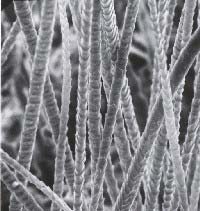Articles and reports from the Life Sciences and chemistry area deal with applied and basic research into modern biology, chemistry and human medicine.
Valuable information can be found on a range of life sciences fields including bacteriology, biochemistry, bionics, bioinformatics, biophysics, biotechnology, genetics, geobotany, human biology, marine biology, microbiology, molecular biology, cellular biology, zoology, bioinorganic chemistry, microchemistry and environmental chemistry.

Group of compounds found in red wine, vegetables simulate benefit of low-calorie diet
Mice, rats, worms, flies, and yeast all live longer on a low-calorie diet, which also seems to protect mammals against cancer and other aging-related diseases. Now, in yeast cells, researchers at Harvard Medical School and BIOMOL Research Laboratories have for the first time found a way to duplicate the benefits of restricted calories in yeast with a group of compounds found in red wine and vegetable

Anyone who made it to high school biology has learned about mitosis, or cell division. One cell divides into two, two into four and so forth in a process designed to pass on exact copies of the DNA in chromosomes to daughter cells. New research, by a University of Georgia team, shows how the genes that control this process are regulated.
The study is important for cancer research because the regulation of cell division goes awry in tumors and normal cell growth and behavior are lost. Unders

A group of scientists led by Dr. Elaine Fuchs at the Howard Hughes Medical Institute at the Rockefeller University have uncovered an unexpected new role for the well-known transcription factor, GATA-3, in hair follicle development. GATA-3 was previously identified for its role in coaxing hematopoietic stem cells towards a T-cell fate. Now, Dr. Fuchs and colleagues reveal that GATA-3 is also involved in epidermal stem cell specification. This finding lends valuable insight into hair follicle generatio

The process by which a cell reads the genetic code in its DNA in order to manufacture a protein is complex, involving dozens of enzymes and other biological molecules working together.
Now, research at Cornell University, using the fruit fly as a model system, has confirmed a theory about one step in the process by showing that a protein complex known as FACT is positioned in living cells at sites where chromosomal DNA is unpacked so that its code can be read. It is part of what the resear

The genetic signal that makes a honeybee male or female has been identified by researchers in Germany, the U.S. and Norway. The finding, published in the August 22 issue of the journal Cell, shows how male bees can have no father, a scientific puzzle going back over 150 years and the explanation for why bees, ants and wasps often form colonial societies. It could also make it easier to breed honeybees.
The researchers found that female bees have two different versions of a gene called csd,

In the United States, nearly 2.6 million couples have been treated for infertility with about 40 percent of those cases thought to be due to male infertility. Now, a study published in the August 22 issue of Cell identifies a new protein that is required for a sperm to bind to an egg during the process of fertilization. This research provides important new insight into the molecular mechanisms that are involved in the initial events of sperm-egg association and may shed light on what underlies some i